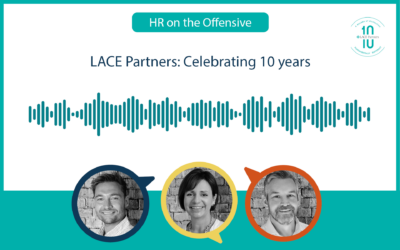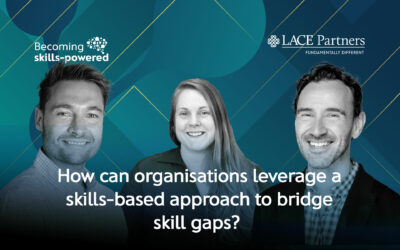In the latest of our employee experience revolution insights, we explore how to demonstrate the value case for investing in better employee experiences (EX) for your people. At LACE, we have worked with a range of businesses to build a compelling EX value case, and in a recent webinar, Kat Bernardes from our team spoke with Duncan Casemore of Applaud on this important topic. Today, we delve deeper into the first trend from Applaud’s 2023 Digital Employee Experience Trend Report, in which 73% of businesses said that their EX strategies don’t align with their C-level objectives.
Few organisations have a mature EX strategy, but those who do are starting to see a return on investment (ROI). A critical component of these strategies is being clear upfront about how to quantify the impact of better EX on business objectives and continuously measuring and adjusting the experience to ensure there is a laser focus on the end goal – business value.
What are the data points you could – and should – be measuring in EX?
Employee experience and the business value it delivers are inherently difficult to measure; but it’s not impossible.
What data points should organisations be measuring when there are intersecting factors and influences at play? How can you be sure what is working?
You can start by establishing a value case for your employee experience and identify the key metrics that tie back to your business objectives. In our experience, looking at multiple metrics and data points across the employee lifecycle helps identify a value chain for organisations to demonstrate the impact of financial and non-financial levers. For example, through better wellbeing programmes (which we also discuss on our recent podcast featuring Gethin Nadin) you can reduce stress-related absenteeism. This can then be correlated against employee engagement and an overall increase in employee productivity.
It’s important to focus on employees as a ‘a whole person’. This includes what their needs are and supporting them throughout the employee life-cycle from initial attraction and joining the business, through to helping them perform whilst they are working within your business. This wider angle gives us clues so that we can identify value drivers.

Applaud’s clients frequently use three core metrics that enhance business value.
1) Productivity: often the biggest dollar number but hardest to translate into tangible savings, is boosted by furnishing employees with swift resolutions to common work queries, aiding them in navigating with fewer clicks and accomplishing routine tasks faster with less friction. Even saving a mere hour weekly can yield substantial benefits.
2) Elevated HR efficacy: realised through a diminished caseload, is attained by delivering an exceptional, consumer-grade tier-zero experience. This not only amplifies employee engagement and alleviates frustration but also liberates HR to concentrate on more value-centric tasks.
3) Augmented engagement: gauged through sentiment analysis and consistent real-time pulse feedback, encapsulating eSat (employee satisfaction) and NPS, fosters a more committed workforce.
How can you collect and quantify EX?
Most businesses collect annual and bi-annual feedback, but do they collect enough data points to help quantify improvements to employees’ micro day-to-day experiences?
Kat says that, for most organisations, the answer is no.
“How often should you conduct pulse surveys?” is a question that we get asked at LACE, and our response often starts by asking the question “What are you trying to measure, and why is it important for the business?”
There is always a balance to be struck; whilst many organisations are very good at collecting broad-scale employee experience feedback, it is important to embed feedback loops such as pulse surveys within experiences themselves so you can identify more specific ways of improving each individual experience.
Having a multi-channel approach to collecting feedback becomes important in ensuring that your employees don’t suffer from feedback fatigue. The ability to go and talk to people, getting ad hoc feedback through conversations is a powerful and simple tool that should not be overlooked. Overlayed with digital EX data points such as adoption metrics will provide a full picture of how the experience delivers the desired outcomes.
For Duncan, continuous and in-the-moment pulse feedback tailored to each employee’s current task can enhance feedback rates and reduce feedback fatigue.
For instance, an in-app single-question popup prompted by a task an employee has just completed (or failed to complete successfully) is an effective way to swiftly capture feedback when they may be motivated to provide it without overloading inboxes with a plethora of annoying email requests.
Coupling this with the capabilities of AI, which can analyse sentiment from every written sentence and spoken word in video calls, provides a data stream capable of unveiling insights and opportunities for improvement within particular departments, locations, personas or moments.
The links between employee experience and customer experience

Kat mentions plenty of research (like this from Harvard Business Review) that explores the link between a great EX and the positive impact on the customer experience (CX).
- Employees who find work highly meaningful are 69% less likely to plan on quitting their jobs within the next six months, have job tenures that are 7.4 months longer on average than employees who find work lacking in meaning.
- Employees who say they have ‘very meaningful’ work spend an additional hour a week working – equivalent to a 2.5% increase in productivity.
- They also take, on average, two fewer days paid leave each year – a further productivity boost of 1%.
- Based on established job satisfaction-to-productivity ratios, a HBR report that ‘highly meaningful work will generate an additional $9,078 (£7,500) per worker, per year versus workers who experience an average degree of meaning’.
- The average salary in the UK is £29,009. Not only are employees willing to take a 23% pay cut to find meaningful work, but the resultant productivity gains are equivalent to a 26% pay rise for every single worker.
Happy employees, engaged and believing in how their work contributes to the organisations purpose, will more naturally provide a better customer experience. Some organisations are taking it a step further to proactively design and improve the way CX and EX are joined across the employee and customer journeys – linking tangible benefits of improved EX to CX feedback and revenue.
For many organisations this link is so powerful that the drive towards having dedicated EX specialists within their business becomes a necessity. For many businesses this is still an evolving mindset; there are certainly large multinationals that have led the way in the thinking that employee experience is ‘front and centre’ of how they design products and services for their people. But for many businesses, the struggle still exists to embed experience in how HR operates and how the business sees experience. That is why getting those metrics and data points that link back to business objectives becomes so vital to demonstrate the value and links between EX and CX.
For many leaders there is a shift that is required – a revolution, if you will – which is to reshape the way that HR is organised and interacts with other teams across the business (including CX) to put experience at the forefront of what they are doing.
Duncan observes how the scope of HR has broadened to such an extent that it prompts a re-evaluation of whether the term “HR” remains fitting.
HR now partners in myriad facets, acting, as we staunchly believe, as the custodians of the employee experience, meticulously crafting every phase of the employee lifecycle in collaboration with the employees themselves and their line of business counterparts.
Doesn’t this mirror what marketers in the B2C realm do for consumers, where the focus extends beyond the purchasing experience to the meticulous design of the entire customer journey?
This evolution necessitates a fundamental shift in mindset, accompanied by a diversification of skills, the adoption of new operating models, and the integration of agile, tech-savvy working methodologies.
So you may be asking, how do we get started?
- Start small and focus in on making a step change in a specific employee experience and connect it to the customer experience
- Be clear on the metrics that will demonstrate value to the business
- Baseline, then measure the impact through a multi-channel approach
- Articulate the value to the C-suite and embark on a broader conversation about how you scale up and build a business case for more EX investment
If you’d like to talk to us about how you are demonstrating ROI and quantifying the success of your EX approaches, reach out to us using the form below and we’ll get in touch.






